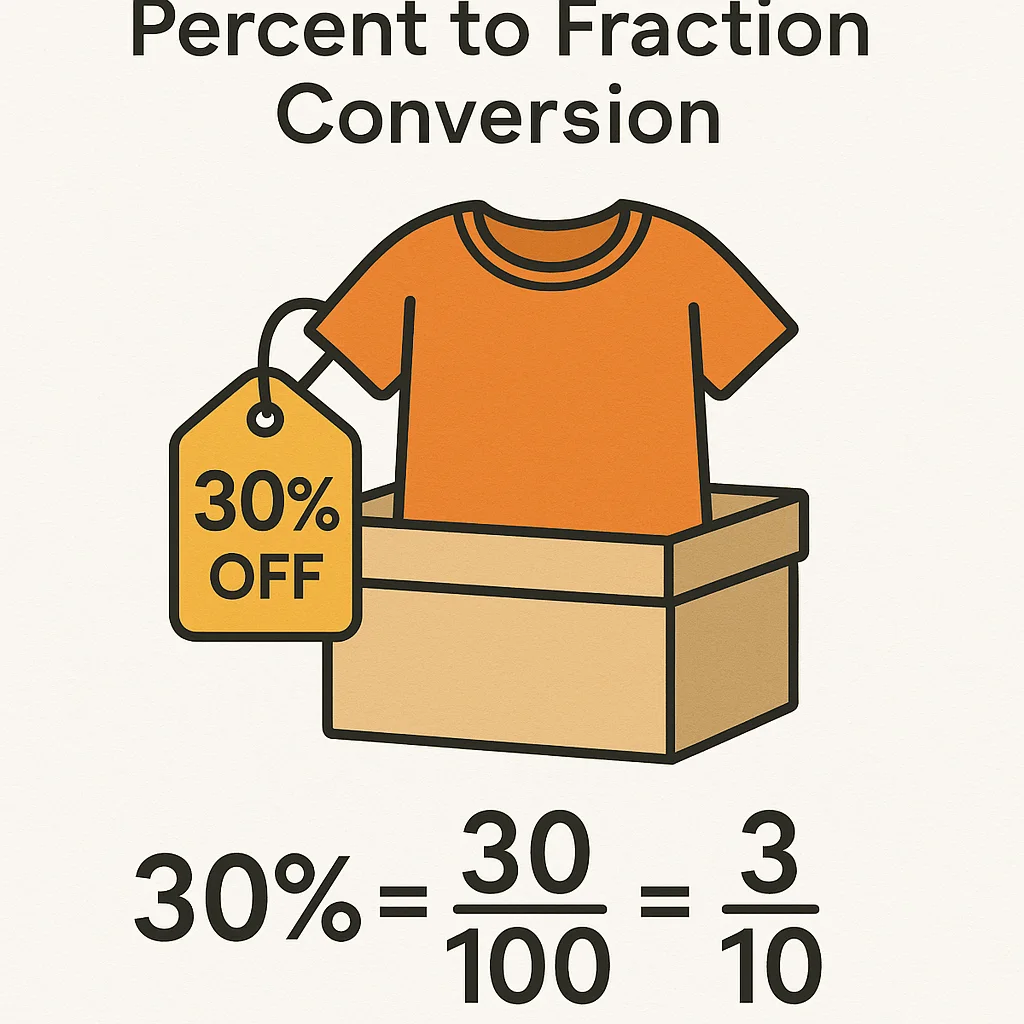Percent to Fraction Conversion
Converting percent to fractions is not just a classroom exercise; it is one of the most important skills that is useful in many real-life scenarios, like shopping, budgeting, cooking, test scores, etc. We almost use percentage to fraction conversion everyday in our lives. For example, to calculate a store discount of 50% we have to convert it into a fraction. Similarly, there are many other scenarios where we convert percent to fraction concept. On this page we have covered step-by-step conversion process along with sample problems and practice questions for you to build a thorough understanding of the topic.
Table of Contents
- What is Percentage?
- What is Fraction?
- How to Convert Percentage into Fraction?
- Step-by-step Conversion Process with Examples
- Problems Based on Percent to Fraction Conversion
- FAQs on Percent to Fraction Conversion
What is Percentage?
‘Percentage’ is derived from a Latin word, ‘per centum’ which means out of a hundred. The basic formula of percentage is P = (Part/Whole) x 100. For example, 50% means 50 out of 100, or half, i.e., 50/100=½, and 100% means the whole amount. To understand in detail follow the step-by-step conversion process along with an example is given below.
What is Fraction?
A fraction shows a part of a whole thing. For example, for a pizza with 5 slices, each slice is represented as ⅕ of the whole. A fraction always has two numbers, a numerator and a denominator, where the denominator can never be 0. To understand in detail, let’s consider you’ve cut an apple into four equal pieces and you eat three of them. The fraction of apple that you ate is represented as 3/4, where 3 is the number of parts you had and 4 is the total number of parts. The part you have on top is the numerator, and the part at the bottom that denotes the whole is called the denominator.
How to Convert Percent into Fraction?
The conversion of percent to fraction is a simple and easy process that involves writing the percentage over 100 and simplifying it to get the result.
Step-by-step Conversion Process with Examples
Step 1: Write the percentage as a fraction over 100
A percentage means “per hundred”. So, just place the number over 100.
Step 2: Simplify the fraction further if possible
Find the greatest common divisor (GCD) of the numerator and denominator, and divide both by it.
For example, to check the discount amount on a t-shirt of ₹1000, simply convert 30% into a fraction by writing 100 in the denominator and simplifying it further and then multiplying it by the t-shirt price. i.e., for a discount of 30%, simply write 30/100 and simplify it further to 3/10, and then multiply the t-shirt price with 3/10.

Problems Based on Percent to Fraction Conversion:
Mastering fraction questions builds a strong foundation for algebra, percentages, and real-world math. By practising more fraction problems, you will become more confident in handling fractions in any form.
Example 1: Convert 75% to a fraction.
Solution:
Step 1: Divide the percent by 100 to get the decimal number.
Step 2: The given percent is a whole number, so go to step 3.
Step 3: Simplify the fraction 75/100.
The answer is 3/4.
Example 2: Convert 62.5% to a fraction.
Solution:
Step 1: Write down the given percent as 62.5/100.
Step 2: The given percent is not a whole number, so multiply both the numerator and denominator by 10 because there is one digit after the decimal point.
Step 3: (62.5x10)/(100x10)
Step 4: Simplify the fraction: 65/1000
The answer is 5/8.
FAQs on Percent to Fraction Conversion
1: How to convert a percentage to a fraction in simplest form?
Answer: To convert the percentage as a fraction, divide the given percentage by 100 to remove the ‘%’ symbol. Reduce the fraction into its simplest form to get the desired result.
2: What is 2% as a fraction?
Answer: Here is a step-by-step process of converting 2% into a fraction:
Step 1: To find the fraction of 2%, divide 2 by 100, that is, 20/100.
Step 2: Simplify 20/100 to get 1/50.
So the fraction of 20/100 is 1/50.
3: Why do we need to learn percentage to fraction conversion?
Answer: Conversion from percentage to fraction is used in real life for cooking, measuring, dividing bills, and more.
4. How do you turn 3/4 into a percent?
Answer: The first step in converting 3/4 is dividing 3 by 4. That is, 3/4 = 0.75
Now, multiply the decimal by 100 to get 0.75 × 100 = 75%
Therefore, 3/4 is equivalent to 75 percent.
Related Links
Admissions Open for
Admissions Open for
CBSE Schools In Popular Cities
- CBSE Schools in Bangalore
- CBSE Schools in Mumbai
- CBSE Schools in Pune
- CBSE Schools in Hyderabad
- CBSE Schools in Chennai
- CBSE Schools in Gurgaon
- CBSE Schools in Kolkata
- CBSE Schools in Indore
- CBSE Schools in Sonipat
- CBSE Schools in Delhi
- CBSE Schools in Rohtak
- CBSE Schools in Bhopal
- CBSE Schools in Aurangabad
- CBSE Schools in Jabalpur
- CBSE Schools in Jaipur
- CBSE Schools in Jodhpur
- CBSE Schools in Nagpur
- CBSE Schools in Ahmednagar
- CBSE School In Tumkur











